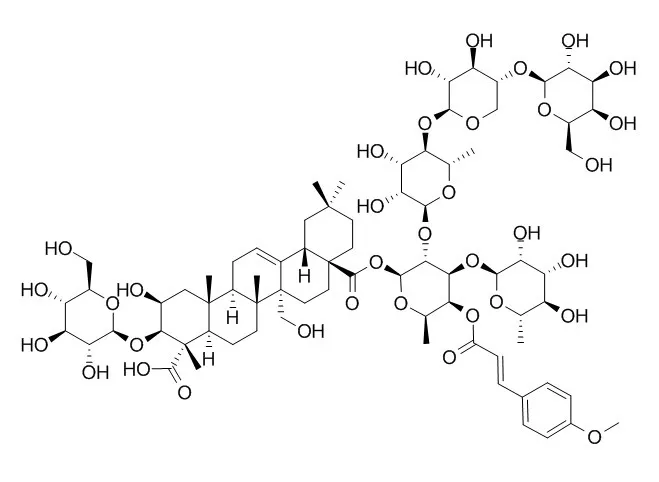| In vitro: |
| Int J Mol Sci. 2013 Nov 15;14(11):22618-41. | | Onjisaponin B derived from Radix Polygalae enhances autophagy and accelerates the degradation of mutant α-synuclein and huntingtin in PC-12 cells.[Pubmed: 24248062] | Emerging evidence indicates important protective roles being played by autophagy in neurodegenerative disorders through clearance of aggregate-prone or mutant proteins.
METHODS AND RESULTS:
In the current study, we aimed to identify autophagy inducers from Chinese medicinal herbs as a potential neuroprotective agent that enhances the clearance of mutant huntingtin and α-synuclein in PC-12 cells. Through intensive screening using the green fluorescent protein-light chain 3 (GFP-LC3) autophagy detection platform, we found that the ethanol extracts of Radix Polygalae (Yuan Zhi) were capable of inducing autophagy. Further investigation showed that among three single components derived from Radix Polygalae--i.e., polygalacic acid, senegenin and Onjisaponin B--Onjisaponin B was able to induce autophagy and accelerate both the removal of mutant huntingtin and A53T α-synuclein, which are highly associated with Huntington disease and Parkinson disease, respectively. Our study further demonstrated that Onjisaponin B induces autophagy via the AMPK-mTOR signaling pathway.
CONCLUSIONS:
Therefore, findings in the current study provide detailed insights into the protective mechanism of a novel autophagy inducer, which is valuable for further investigation as a new candidate agent for modulating neurodegenerative disorders through the reduction of toxicity and clearance of mutant proteins in the cellular level. | | Biomed Res Int. 2015;2015:918048. | | The gastrointestinal irritation of polygala saponins and its potential mechanism in vitro and in vivo.[Pubmed: 25705699] | Processing alters the pharmacological activity and reduces the gastrointestinal toxicity of the polygalae.
METHODS AND RESULTS:
To investigate the effect of processing, different glycosyl substituent products were tested. Hypnotic and subhypnotic doses of pentobarbital-induced sleep tests on mice were used to evaluate the sedative activity of polygala saponins with different glycosyl substituents; isolated gut motility experiment was employed to study excitatory effects of different polygala saponins; the gastrointestinal irritation effects of different polygala saponins were compared by measuring the levels of gastric PGE2 and intestinal TNF-α on mice. When compared with control, Onjisaponin B (OJB) and tenuifolin (TEN), but not senegenin (SNG), significantly increased the number of sleeping mice and prolonged the sleeping time (P < 0.05); 80, 40, and 20 mg/L of OJB and 80 mg/L of TEN, but not SNG, obviously changed the amplitude and frequency of isolated jejunum (P < 0.05); all the three compounds significantly decreased the level of gastric PGE2 but had no obvious influences on the reduction of intestinal TNF-α level. For sedative and hypnotic effects, OJB > TEN > SNG; for the protection form gastrointestinal irritation and damages, OJB > TEN > SNG.
CONCLUSIONS:
Therefore, in processing Polygala, glycosyl breaking may be related to the decline of pharmacological activity and gastrointestinal toxicity of polygala saponins. |
|






 Cell. 2018 Jan 11;172(1-2):249-261.e12. doi: 10.1016/j.cell.2017.12.019.IF=36.216(2019)
Cell. 2018 Jan 11;172(1-2):249-261.e12. doi: 10.1016/j.cell.2017.12.019.IF=36.216(2019) Cell Metab. 2020 Mar 3;31(3):534-548.e5. doi: 10.1016/j.cmet.2020.01.002.IF=22.415(2019)
Cell Metab. 2020 Mar 3;31(3):534-548.e5. doi: 10.1016/j.cmet.2020.01.002.IF=22.415(2019) Mol Cell. 2017 Nov 16;68(4):673-685.e6. doi: 10.1016/j.molcel.2017.10.022.IF=14.548(2019)
Mol Cell. 2017 Nov 16;68(4):673-685.e6. doi: 10.1016/j.molcel.2017.10.022.IF=14.548(2019)